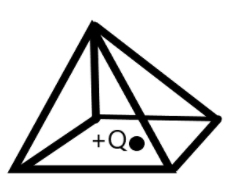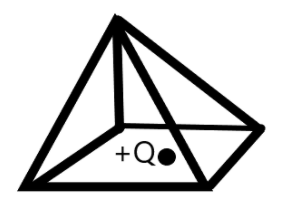
A point charge +Q is positioned at the center of the base of a square pyramid as shown in the figure. What is the electric flux through one of the four identical upper faces of the pyramid?


Answer
560.1k+ views
Hint: We need to understand the relation between the charge placed in a system, the orientation of the system and the electric flux passing through a plane. We can use the Gauss’ law in electrostatics to find the solution for the magnitude of flux.
Complete answer:
The electric charges are the primary sources of the electric field. We know from the basic electrostatics that a positive point charge has an electric field emerging from the charge and going out to infinity and a negative charge has an incoming direction for the electric field.
The strength of the electric field is dependent on the magnitude of charge possessed by the charge and inversely proportional to the distance from the charge to the point where the electric field is being calculated.
The electric flux is defined as the electric field through a plane surface equidistant from the point charge. If we consider a point charge, then the equidistant points join together to form a spherical surface. So, the electric flux can be mathematically given from the gauss’ law as –
\[\begin{align}
& \phi =\int{{}}E.dA \\
& \Rightarrow \phi =\dfrac{1}{4\pi {{\varepsilon }_{0}}}\dfrac{q}{{{r}^{2}}}4\pi {{r}^{2}} \\
& \Rightarrow \phi =\dfrac{q}{{{\varepsilon }_{0}}} \\
\end{align}\]

So, in the present situation the electric flux emerging from the point charge can be given as –
\[\phi =+\dfrac{Q}{{{\varepsilon }_{0}}}\]
We know that we need to find the flux through one of the identical faces of the square pyramid. Since the flux can be considered only in the upward direction, the flux that passes through the pyramid reduces to –
\[\phi =+\dfrac{Q}{2{{\varepsilon }_{0}}}\]
Now, when we consider one face of the pyramid, the flux again reduces by one-fourth of the above value. So, the electric flux through one of the faces of the pyramid becomes –
\[\begin{align}
& \phi =\dfrac{1}{4}\dfrac{Q}{2{{\varepsilon }_{0}}} \\
& \therefore \phi =\dfrac{Q}{8{{\varepsilon }_{0}}} \\
\end{align}\]
The flux through one of the four identical faces of the square pyramid is \[\dfrac{Q}{8{{\varepsilon }_{0}}}\].
This is the required solution.
Note:
The electric flux turns out to be a scalar quantity as its direction is insignificant. Also, it is the dot product of the electric field and the area element of the surface. The positive charges have flux going out of the surface and the reverse for the negative charges.
Complete answer:
The electric charges are the primary sources of the electric field. We know from the basic electrostatics that a positive point charge has an electric field emerging from the charge and going out to infinity and a negative charge has an incoming direction for the electric field.
The strength of the electric field is dependent on the magnitude of charge possessed by the charge and inversely proportional to the distance from the charge to the point where the electric field is being calculated.
The electric flux is defined as the electric field through a plane surface equidistant from the point charge. If we consider a point charge, then the equidistant points join together to form a spherical surface. So, the electric flux can be mathematically given from the gauss’ law as –
\[\begin{align}
& \phi =\int{{}}E.dA \\
& \Rightarrow \phi =\dfrac{1}{4\pi {{\varepsilon }_{0}}}\dfrac{q}{{{r}^{2}}}4\pi {{r}^{2}} \\
& \Rightarrow \phi =\dfrac{q}{{{\varepsilon }_{0}}} \\
\end{align}\]

So, in the present situation the electric flux emerging from the point charge can be given as –
\[\phi =+\dfrac{Q}{{{\varepsilon }_{0}}}\]
We know that we need to find the flux through one of the identical faces of the square pyramid. Since the flux can be considered only in the upward direction, the flux that passes through the pyramid reduces to –
\[\phi =+\dfrac{Q}{2{{\varepsilon }_{0}}}\]
Now, when we consider one face of the pyramid, the flux again reduces by one-fourth of the above value. So, the electric flux through one of the faces of the pyramid becomes –
\[\begin{align}
& \phi =\dfrac{1}{4}\dfrac{Q}{2{{\varepsilon }_{0}}} \\
& \therefore \phi =\dfrac{Q}{8{{\varepsilon }_{0}}} \\
\end{align}\]
The flux through one of the four identical faces of the square pyramid is \[\dfrac{Q}{8{{\varepsilon }_{0}}}\].
This is the required solution.
Note:
The electric flux turns out to be a scalar quantity as its direction is insignificant. Also, it is the dot product of the electric field and the area element of the surface. The positive charges have flux going out of the surface and the reverse for the negative charges.
Recently Updated Pages
A man running at a speed 5 ms is viewed in the side class 12 physics CBSE

The number of solutions in x in 02pi for which sqrt class 12 maths CBSE

State and explain Hardy Weinbergs Principle class 12 biology CBSE

Write any two methods of preparation of phenol Give class 12 chemistry CBSE

Which of the following statements is wrong a Amnion class 12 biology CBSE

Differentiate between action potential and resting class 12 biology CBSE

Trending doubts
What are the major means of transport Explain each class 12 social science CBSE

Which are the Top 10 Largest Countries of the World?

Draw a labelled sketch of the human eye class 12 physics CBSE

Explain sex determination in humans with line diag class 12 biology CBSE

Explain sex determination in humans with the help of class 12 biology CBSE

Differentiate between homogeneous and heterogeneous class 12 chemistry CBSE




